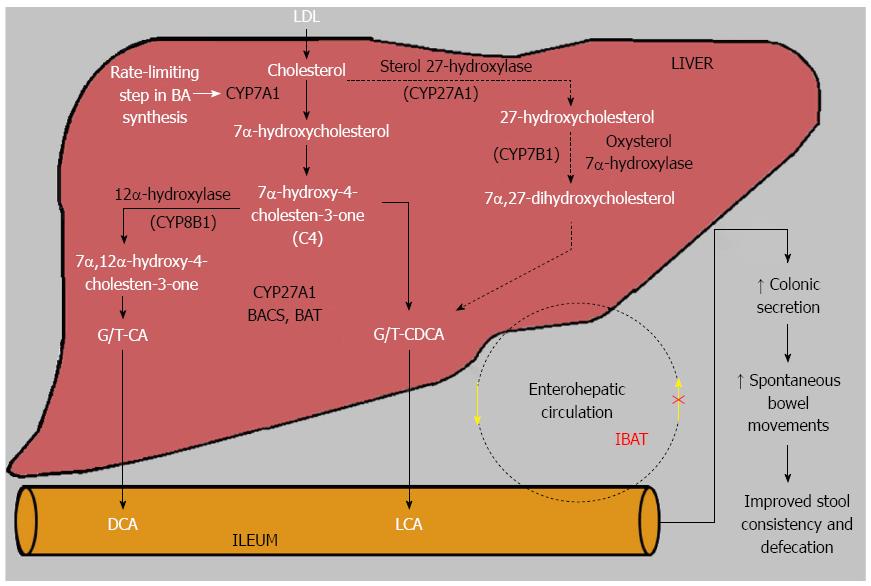Copyright
©The Author(s) 2015.
World J Gastroenterol. Jun 28, 2015; 21(24): 7436-7442
Published online Jun 28, 2015. doi: 10.3748/wjg.v21.i24.7436
Published online Jun 28, 2015. doi: 10.3748/wjg.v21.i24.7436
Figure 1 Effect of ileal bile acid transporter in the proximal ileum.
BA synthesis is a major metabolic pathway for catabolism of cholesterol. Primary BAs, CA and CDCA, are obtained via the alternative (acidic) pathway, initiated by mitochondrial CYP27A1, or by the classical (neutral) biosynthetic pathway, catalyzed by microsomal CYP7A1. CYP7A1 is a rate-limiting enzyme that regulates the overall rate of BA synthesis in the liver. The activity of CYP7A1 depends upon the quantity of BAs absorbed in the intestine. Inhibition of IBAT contributes to upregulation of BA synthesis and therefore promotes the maintenance of BA pool size. Simultaneously, a decrease in the concentration of serum LDL and an increase of C4 level, which is a surrogate for CYP7A1 activity, may occur. BACS and BAT are two key enzymes involved in the conjugation of BA to amino acids (G or T). In the intestine, conjugated G/T-CDCA and G/T-CA are dehydroxylated to the secondary BAs, DCA and LCA. The action of a selective IBAT inhibitor increases the concentration of BAs entering the proximal colon, which in turn stimulates colonic motility and secretion resulting in enhanced laxative properties. BA: Bile acid; BACS: Bile acid CoA synthase; BAT: Bile acid amino acid transferase; CA: Cholic acid; CDCA: Chenodeoxycholic acids; CYP27A1: Sterol 27 hydroxylase; CYP7B1: Nonspecific 7α-hydroxylase; DCA: Deoxycholic acid; G: Glycine; IBAT: Ileal bile acid transporter; LCA: Lithocholic acid; LDL: Low-density lipoprotein; T: Taurine. Modified from[34-37].
- Citation: Mosińska P, Fichna J, Storr M. Inhibition of ileal bile acid transporter: An emerging therapeutic strategy for chronic idiopathic constipation. World J Gastroenterol 2015; 21(24): 7436-7442
- URL: https://www.wjgnet.com/1007-9327/full/v21/i24/7436.htm
- DOI: https://dx.doi.org/10.3748/wjg.v21.i24.7436









